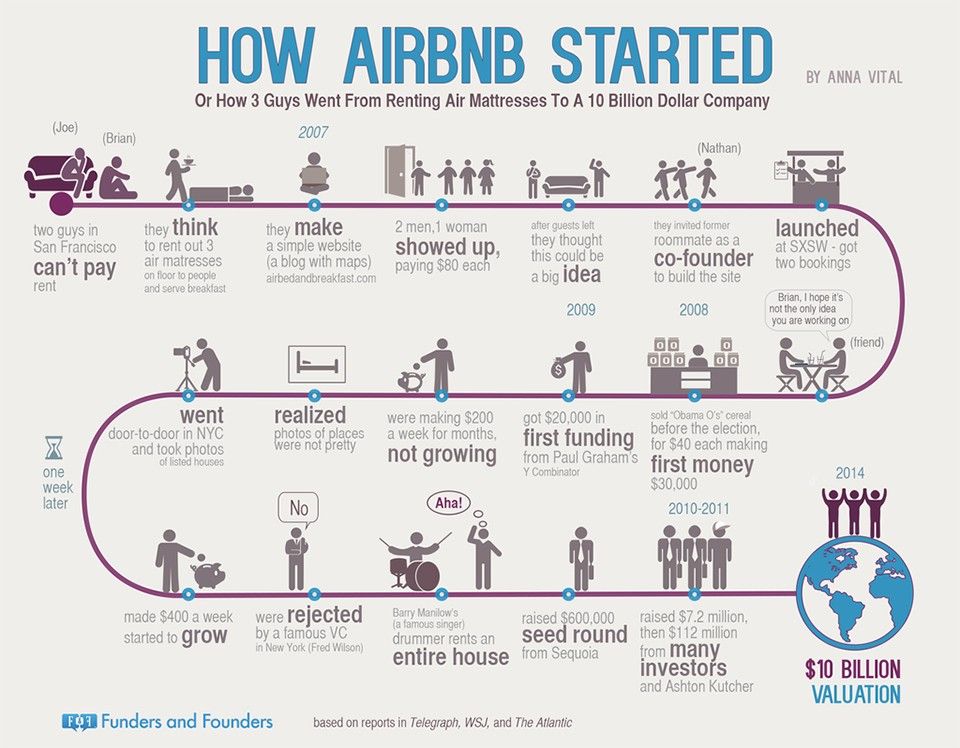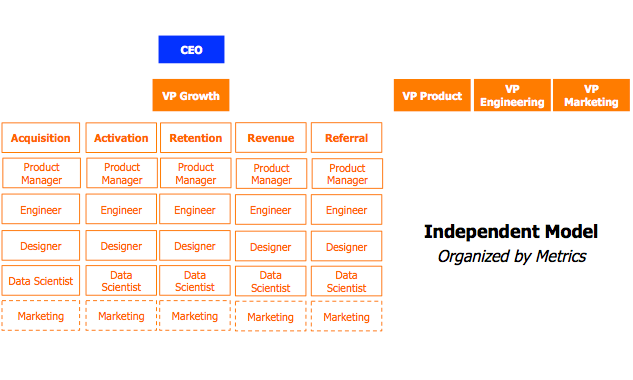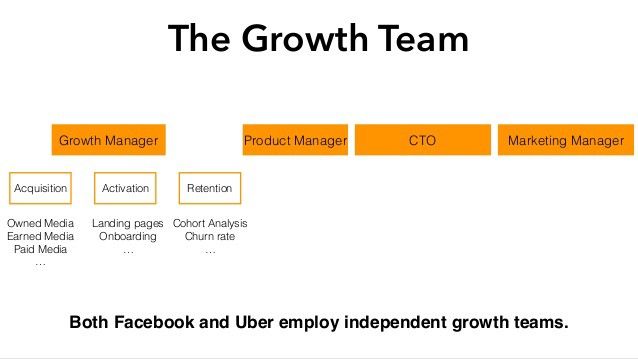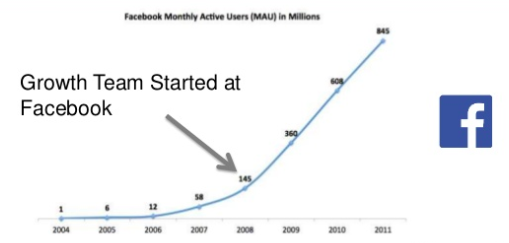How to fit a growth team into the organization (practical examples)

Growth and structuring your growth team doesn’t have to be hard.
I know, we’ve all heard the stories: a startup didn’t hire the growth team or they didn’t get the results they wanted. VP of Growth didn’t excel at that role, and so on.
But here’s the thing: if you want to accelerate your growth, you need a growth team. And there are proven examples of how to fit a growth team into your organization.
In this article, I’m going to show you what your Head of Growth should be doing, how major companies like AirBnB and Facebook fit their growth teams into their organizations, and how you can make your growth team work in sync with the rest of your organization.
1. First Step: hire your Head of Growth
In our article on structuring a growth team, we spent a lot of time talking about how to hire the right VP/Head of Growth for your organization.
This is definitely one of the most responsible and important roles in your growth team, but in your company in general.
If you’ve got a good Head of Growth, you can rest easy.
What does a Head of Growth do?
A Head, or VP of Growth at your organization is also often called Growth Manager.
Your Head of Growth has to be able to manage:
- Marketing
- Product development
- User acquisition
- User activation and retention
In short, they’re your go-to person for all things related to growth.
This is a specific role because Heads of Growth operate at the intersection of all these aspects. They make sure that each part of the process is perfectly optimized to acquire and retain as many users as possible.
It’s necessary for this function to be cross-departmental.
For many companies, this means that hiring an independent growth team is the easiest way forward. Instead of managing tens and hundreds of employees across the company, your Head of Growth manages specific team members.
Key responsibilities for Heads of Growth
What will the process look like in your company, once you structure and hire your Head of Growth? With all the responsibilities in mind, what does a day in the life of a Head of Growth look like?
First, your VP of Growth will help your company define the growth objective.
This is crucial for the rest of your operations. Normally, it’s best for the growth team to focus at one funnel stage at a time.
For example, if you’ve been working for a while, you might want to focus your growth on retention or combating churn.
If you’re just starting out, your growth team’s focus will have to be on user acquisition.
From there, your Head of Growth will create strategies and initiatives, as well as define the necessary metrics to track your progress.
It’s a very hands-on role. And even though many perceive it to be vague, it has to be backed by concrete data and metrics that will show you what you are doing right, and how you can optimize your growth further.
A Head of Growth also has to constantly evaluate and prioritize initiatives:
- How will the initiative impact growth if (un)successful?
- How sure is the team that the initiative will result in growth?
- How many resources will the team need to implement the initiative?
In a sea of great ideas, the VP of Growth needs to be the one to calmly approach an initiative or a change, and decide whether it will actually align with the goals and contribute to growth.
However, your Head of Growth’s most important responsibility is having all the answers.
- Why are users canceling their plans?
- Why do users like this more than that?
- What can we do to improve growth, and why will that be successful?
They’re the only person in an organization that doesn’t have the liberty of shrugging and saying: “That’s just the way things are.”
Instead, they have to back their claims and plans with data and customer insight.
If the Head of Growth has the right data, they can make good decisions. And so a really good Head of Growth will never settle for guesstimates.
Instead, they’ll hound data to make the best possible decisions for your organization’s growth. And because you want to replicate successful processes, they’ll know exactly what worked.
Who does Head of Growth report to?
Depending on where your growth team lies in the hierarchy of your organization, your Head of Growth could report to:
- The CEO
- The VP
Since their role is a bit out of the standard framework, they should report directly to the persons in the highest position of your organizational hierarchy. This allows them to focus solely on growth, instead of navigating the ladder and constantly reporting to different people.
Good Heads of Growth work best when they’re given all the support they need, and left alone to do what they do best: initiate growth with their team.
Keep in mind: your Head of Growth will take care of hiring the entire growth team.
After understanding your goals, they’ll find the people with the right skills for achieving them. So that’s one task off your plate, but all the more reason to find the right person for the job.
And once that’s taken care of, it’s time to figure out how your growth team will operate, and how you can best support your Head of Growth.
2. Learn from the greats: growth team examples
Many of the household names we know and love today started out as small startups that needed to grow. They were revolutionary, so a lot of their target audience members didn’t yet know they needed their services.
They just knew they had problems to solve.
And because they had great Heads of Growth and growth teams who doubled-down on what worked, they were able to become the powerhouses they are today.
Without further ado, let’s take a look at how they did it:
2.1. AirBnB’s growth team

AirBnB’s journey started in 2008, with two founders and a very small budget. Today, their stock value is $35 billion.
You’ve probably heard of their journey in terms of using other people’s networks (they re-posted listings to Craigslist to reach more people), and even selling cereal boxes to get money to expand.
The founders definitely did all they could. But AirBnB’s team was responsible for such explosive growth.
Mona Gandhi, the first female engineer at AirBnB, was also the founder of AirBnB’s growth team.
Her philosophy?
“Growth can be simplified with one word — distribution. How can you introduce more people to you and your product?”
Within AirBnB’s organization structure, Gandhi’s growth team has a certain degree of independence. Their main goal was customer acquisition, so the growth team created a referral program that allowed them to reach even more customers.
Thanks to Gandhi’s independent growth team, AirBnB grew from 20,000 to 500 million users.
2.2. Uber’s growth team
Uber, another startup with explosive growth, also hired a growth team.
From a motley crew of barely a dozen, Uber’s growth team now has over 300 members that operate within Uber’s organizational structure, almost like a separate department.
In the words of Paul Clayton Smith,
“We touch all parts of Uber — product, marketing, and internal tools. We design for riders, drivers, and operations teams across the 68 countries where Uber operates. Everything we do gets tested, tracked, and measured to ensure we’re maximizing growth in all areas of the company.”
What we’re seeing here is the independent model, in which the growth team operates separately from the regular organizational structure. It’s just massively scaled to fit 68 countries.
The independent model is the best option if you really want to focus on growth.
Otherwise, your team members could get distracted by their daily, departmental tasks.

They work smart, move fast, and make sure every decision is backed by data that proves customers will love their initiatives or changes.
And just like AirBnB, Uber had a great product — they just needed distribution. Their growth team made sure their loyal users showed their product to all their friends.
2.3. HubSpot’s growth team
HubSpot’s growth team is deeply embedded into their organization. They make sure they stimulate product-led growth, even though they are relatively independent.
HubSpot first started experimenting with an independent growth team in 2015.
By 2017, they had a fully-formed growth team that was in charge of:
- Understanding customer behavior
- Shaping initiatives that attracted users
- Experimenting (they ran over 150 experiments in 2018)
They also gather a staggering amount of data, which would be impossible if HubSpot didn’t have such a growth-driven culture in place. Otherwise, they would struggle with data silos, which is one of the main pitfalls of the independent growth team structure.
From there, they “democratized” growth across the product team.
So in addition to having a specially-formed growth team, HubSpot also took their growth team findings to other departments within the company.
With time, HubSpot managed to migrate into a hybrid model.
This is a natural turn of events for many companies and startups.
While things are chaotic in the beginning, as the growth team demonstrates their value (and the value of their experiments), more and more people in the company will be willing to cooperate and adopt their principles.

However, Kieran Flanagan, HubSpot’s VP of Marketing and Growth, says that it’s necessary to have the right tools and processes to stimulate growth across the organization.
It was crucial to have marketing and engineering collaborate on product design. Marketers supplied customer insight, while engineers supplied their perspective on how the product could best achieve that.
In the end, HubSpot encouraged synergy that created products with growth in mind.
2.4. Pinterest’s growth team
Pinterest opted for a hybrid model when structuring their growth team and fitting them into their organization.
In the words of Jeff Chang and John Egan, Growth Engineers at Pinterest, Pinterest chose to adopt a bottoms-up model that would scale well over time.

In practice, this means that everyone employed at Pinterest is a part of the growth team, with a few designated engineers and marketers in charge of implementing the initiatives others proposed.
And while everyone has their “regular” jobs, they also operate as a part of the growth team.
This allows Pinterest to never run out of ideas, while also making sure that no growth team members are sitting around, idly waiting for the next big thing.

They have also divided a portion of their departments into growth teams dealing with specific parts of user journey. Jeff Chang calls them “atomic teams.”
However, this structure uniquely works for Pinterest because they’re the kind of company that focuses on ideation first, and has a strong, idea-driven culture that allows everyone to feel the ownership over the product.
In the long term, “embedding” growth team members into other departments, i.e. making everyone a part of the growth team, means a better culture and a renewed growth-driven focus.
At Pinterest, Growth Heads are simply there to make sure that the ideas are valid, and to double-check before they let enthusiasm carry them away into an initiative that is not feasible.
2.5. Facebook’s growth team
Finally, the social network to rule all social networks, Facebook, also has a growth team responsible for their user acquisition success. With over 2.5 billion monthly active users, you know they’re doing something right.
But how do they figure into the company’s overall structure and hierarchy?

Just like Uber, Facebook created an independent growth team comprised of engineers and marketers. And just like the majority of unicorn startups, Facebook chose to follow the “funnel route.”
The Head of Growth, Chamath Palihapitiya, got data engineers, product engineers, marketers, and other growth team members together, while dividing them internally according to different funnel phases:
- Acquisition
- Activation
- Retention
- (Resurrection for users who left)
At Facebook, the growth team had immense executive support.
They were allowed to take big risks because the goals were big: getting the whole world to sign up.

With time, the growth team became the horizontal backbone of the entire company.
It completely informed everyone’s mindset to the point where, as Andy Johns (former Product Manager of Growth at Facebook) puts it, everyone stopped asking about performance and stability of features, and instead started asking:
“What’s the impact on growth if we build and ship ‘X’?”
3. How to fit a growth team into your organization
The main thing the aforementioned companies had going for them was the fact that their employees believed in their product.
There’s nothing like enthusiasm to stimulate growth.
Normally, when you have an independent growth team, you can face a lot of friction from other departments.
If the growth team members act like rock stars who don’t need permission from anyone, move fast and break things, it’s bound to cause negative feelings.
However, if you have a functional growth team integrated into your organization, with members of departments working on growth projects, you’re risking distractions and resource conflicts.
The solution?
Create your own growth strategy, and make sure the foundations include culture.
Step 1. Create a growth team as soon as possible
There’s no substitute for establishing the standards and expectations early on.
If you hire a growth team as you’re scaling, while you still don’t have a lot of employees, then having a growth team on board becomes much easier to handle for the rest of your company in the long term. It becomes a normal part of the process.
This is especially important for independent growth team structures.
However, even if you have a functional growth team, establishing tasks and responsibilities in the beginning helps. Your entire company (growth team members included) has to be aligned around the same goals.
So if John from Product Design has to handle a significant portion of Growth Team tasks, while handling his standard workload, then his first superior should have no objections.
This was the case with Pinterest, where they used a decentralized structure to make everyone feel like a part of the growth team.
Step 2. Make expectations clear
The first expectation you should clarify is: who should the growth team members report to?
This is really important if you’re creating a sales funnel growth team, or a growth team for separate functions: lead generation (acquisition), product (retention), and so on.
In that case, department heads can be Heads of Growth.
It’s always a problem when growth team members have to report to two different people, so it’s important for the Heads to prioritize growth across initiatives.
This is where metrics and goals help.
Step 3. Avoid confusion and reinforce goal alignment
Too many cooks spoil the broth.
The same thing happens when you’re growing your startup, and you’ve got dozens of different metrics and goals to achieve.
It’s chaos, and nothing gets done in full.
If you truly want to fit your growth team into your organization, you need the entire organization be aligned around 1 goal and 1 true-north metric.
For Facebook, that was user acquisition, and the metric was the number of new users.
The entire organization (not just the growth team) worked to do their job so it contributed to user growth.
Even though the company had an independent growth team, everyone in the company still supported their efforts because their job was growth, too, just not as intensive.
Step 4. Cross-departmental collaboration
There are two benefits of having a growth team comprised of people with different backgrounds.
The first benefit is obvious — they can see the whole picture that you need to grow.
The second benefit is that they’re the evangelists of growth within your organization. They can “convince” their native team that your goals are worthwhile, and motivate them to do their best to help.
Cross-departmental collaboration and goal alignment also help with breaking down data silos.
You’ll get a free flow of data between the relevant teams and people in your organization, making sure your growth team has all the information they need to grow your startup.
Step 5. Customize and fit your growth team
While all of the examples above follow some sort of a predefined growth structure, they have made plenty of customizations to fit their journey.
No two startups are alike. They have different goals, and different teams.
So when creating your own growth team, make sure you consider your unique strengths and weaknesses.
Maybe you’ll find that your team has no problem balancing regular tasks with growth team tasks.
On the other hand, maybe your model will end up a mix of both.
But whichever model you choose, make sure your entire company knows how important it is to grow.
Only then will you experience what it feels like when every employee of the company wakes up in the morning ready to help you succeed.
No spam, no sharing to third party. Only you and me.
